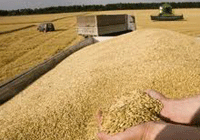
World food prices fall; inflation fear remains
Milan, May 3, 2012
World food prices eased in April after rising in the first quarter of this year, the United Nation's food agency said, but inflation worries are still simmering as soybean prices climb.
Record high food prices last February helped to fuel the Arab Spring uprisings in the Middle East and North Africa. Prices receded in the second half of 2011 but the uptrend resumed in January.
The FAO Food Price Index, which measures monthly price changes for a food basket of cereals, oilseeds, dairy, meat and sugar, averaged 214 points in April, down from revised 217 in March, the UN's Food and Agriculture Organisation (FAO) said on Thursday.
Yet soybean prices - at their highest since July 2008 - are likely to rise further due to tight supplies, driving corn prices higher, the agency's senior economist said.
The index drop reflected a 2.5 percent month-on-month fall in maize prices, a 1 percent fall in wheat and a 5 percent drop in sugar prices, which offset a 2.2 percent rise in vegetable oils fuelled by soaring soybean prices.
'You would see prices most likely remaining under downward pressure in the next couple of months,' the FAO's senior economist and grain analyst Abdolreza Abbassian told Reuters, adding that weather remained a critical factor.
The index seems to have stabilised at a relatively high level of around 214 points, the FAO said in a monthly update. Last week, the World Bank said costlier oil, strong demand from Asia and bad weather had been pushing up global food prices, adding that if current production forecasts for 2012/2013 do not materialise, prices could reach higher levels.
US soybean futures, one of the major drivers on international grain markets in the past few months, have been fuelled by continuous purchases from China, the world's largest buyer.
'For the (FAO) index, the conditions associated with oilseeds especially have been supportive,' Rabobank senior commodity analyst Keith Flury said.
While record total cereal crops are expected this year, strong demand coupled with low initial stocks are likely to lead to tight supplies of coarse grains and soybeans which would support prices, the FAO said in its Food Outlook.
The FAO has cut its outlook for the world new crop wheat output to 675 million tonnes from an earlier forecast of 690 million, down 3.6 percent from last year, citing output falls in Ukraine, Kazakhstan, China, Morocco and the European Union.
International wheat prices in 2012/13 are expected to average lower than in the previous crop year, despite smaller crops and shrinking stocks, due to a fall in consumption and large export supplies, the FAO said.
World cereals output is expected to rise in 2012/13 crop year by 1.1 percent to a record 2.371 billion tonnes, boosting closely watched stocks by 1.7 percent to 524 million tonnes at the end of the 2012/13 seasons, the agency said in its first forecast of new grain crops.
Coarse grains production is seen rising 3.7 percent to 1.207 billion tonnes, driven by a 4.1 percent increase in maize (corn) output to 916 million tonnes, the agency said citing preliminary forecasts. But the coarse grains market is set to remain tight due to very low level of stocks, providing further support to prices, it said.
World prices of oilcrops and their derived products, which have been rising since the start of this year, are likely to remain firm due to an increasingly tight supply and demand situation of the current season, it said.
World soybean output is estimated to fall 9.5 percent to 240 million tonnes in 2011/12 year and the likelihood that soybeans would have to compete for cropland with maize, especially in the United States, in 2012/13 adds further support to prices, it said. - Reuters







